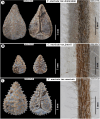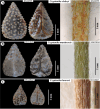Cryptanthaacrimuricata (Boraginaceae), a distinctive new taxon of series Muricatae
- PMID: 39777400
- PMCID: PMC11704739
- DOI: 10.3897/phytokeys.250.138635
Cryptanthaacrimuricata (Boraginaceae), a distinctive new taxon of series Muricatae
Abstract
In the process of studying the species Cryptanthamuricata and its varieties, we discovered a unique taxon of the genus that resembles C.muricata but differs in having a mostly densely white-strigose stem vestiture (sometimes with spreading trichomes) and tuberculate to muricate nutlets with often whitish tubercles that are, in comparison with typical C.muricata, larger, with a wider base and more pointed apex, and more densely spaced. We believe this form to be different enough to describe as a new species, Cryptanthaacrimuricata. This new species occurs in southwestern North America: in California and Arizona of the United States and in northern Baja California, Mexico. It occurs in mid- to relatively high elevation mountain regions of mostly desert transition/escarpment in the Transverse and Peninsular Ranges, in the Sonoran and Mohave Deserts, and with some populations scattered in the southern Sierra Nevada. We believe this new species to be closely related to C.clokeyi, C.martirensis, C.muricata, and possibly C.hooveri, of Cryptantha series Muricatae. Detailed molecular phylogenetic are needed to better establish their interrelationships.
Keywords: Boraginaceae; Cryptantha; Cryptanthamuricata; series Maritimae; series Muricatae; taxonomy.
Michael G. Simpson, Lee M. Simpson, James M. André.
Conflict of interest statement
The authors have declared that no competing interests exist.
Figures





References
-
- Amsinckiinae Working Group (2024) Systematics of Amsinckiinae (Boraginaceae): The Popcornflowers. https://plants.sdsu.edu/amsinckiinae
-
- Bowdler N. (2010) Thousands of plant species ‘undiscovered in cupboards’. BBC News Science & Environment. https://www.bbc.com/news/science-environment-11913076 [accessed 27.09.2024]
-
- Chacón J, Luebert F, Hilger HH, Ovcinnikova S, Selvi F, Cecchi L, Guilliams CM, Hasenstab-Lehman K, Sutorý K, Simpson MG, Weigend M. (2016) The borage family (Boraginaceae s.str.): A revised infrafamilial classification based on new phylogenetic evidence, with emphasis on the placement of some enigmatic genera. Taxon 65(3): 523–546. 10.12705/653.6 - DOI
-
- CNPS Inventory (2024) California Native Plant Society Rare Plant Program, Rare Plant Inventory (online edition, v9.5). https://www.rareplants.cnps.org [accessed 04.10.2024]
-
- Cronquist A. (1978) Once again, what is a species? In: Ramberger JA. (Ed.) Biosystematics in Agriculture.Allanheld & Osmun, Montclair, NJ, 3–20.
LinkOut - more resources
Full Text Sources
Miscellaneous
